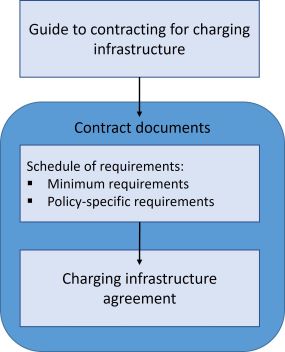Guide to contracting for charging infrastructure
This document can be used by commissioning parties to enter into contractual arrangements with market operators for the installation, management, and/or operation of charging infrastructure in public, semi-public, or private spaces. When preparing to contract with a market operator, there are a number of decisions to make and add-ons to choose from. This document provides insight into, and guidance, on making these decisions as well as choosing add-ons, and is to be used by public authorities and other contracting parties, including private parties such as car park operators.
How can this guide be used?
This document sets out the main decisions to be made when purchasing recharging points. The document can be used by commissioning parties regardless of whether they have experience in the subject.
Alongside this guide, a set of minimum and policy-specific requirements for charging infrastructure is available, as well as a template agreement.
The minimum requirements should always be applied. They were developed in cooperation with a large number of government bodies and market and grid operators. The policy-specific requirements may be applied by the commissioning party depending on its own aims or ambitions. The minimum and policy-specific requirements are set out in a single document, the schedule of requirements. This document is available in editable format (Word) so that it can be used as a basis for new contracts and tenders. It should be noted that these requirements focus on regular charging infrastructure (AC chargers) and not on fast charging infrastructure (DC chargers). The schedule of requirements can be used in conjunction with an agreement to form a contract document.
Methodology
Start by using this guide to consider decisions and choose add-ons, and to learn from existing contracts. Then use the schedule of requirements as a starting point to draw up your own contract document, deciding which policy-specific requirements you would like to include in addition to the minimum requirements. Finally, you may have additional requirements you want to include, which are not present in the schedule of requirements.
A schematic representation of how to apply this methodology is given in the figure below.

Decisions and add-ons
The guide distinguishes between decisions and add-ons. Decisions must always be made, whereas add-ons are optional. This document covers the following decisions and add-ons:
Decisions: 1. scope 2. deployment strategies 3. contractual arrangements. | Add-ons: 1. innovations 2. smart recharging and energy services.
|
These decisions and add-ons are further developed in this document. Each decision or add-on, provides an explanation, an insight into the consequences, and highlights a number of things to consider. It also provides a number of guidelines to be integrated into the contract documents, building on existing contracts and lessons learned from contracting authorities. For each topic, an existing contract is referenced to draw on lessons learned elsewhere.
How has this document been produced?
This guide draws on experience gained from recent calls for tenders for public and semi-public charging infrastructures. The tenders were analysed based on a number of principles. In-depth interviews with both contracting authorities and market operators were also carried out.
The first decision to be made when drawing up a contract is in defining its scope. The scope contains the following elements:
For the construction, maintenance and operation of charging infrastructure, the commissioning party and the market operator enter into a contract together. This contract sets out arrangements on the division of responsibilities. This division therefore goes beyond the technical responsibilities laid down in the demarcation.


